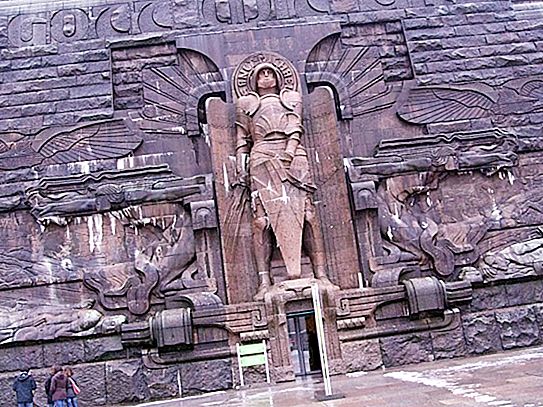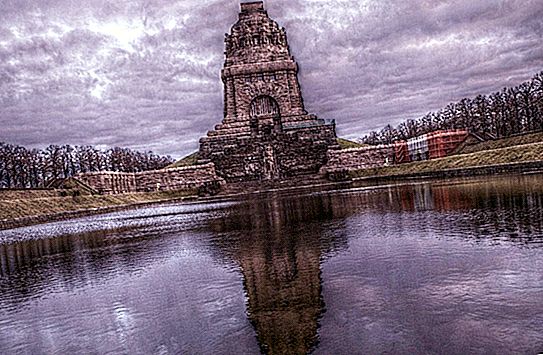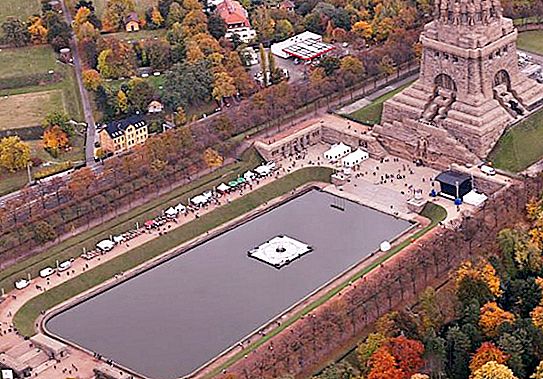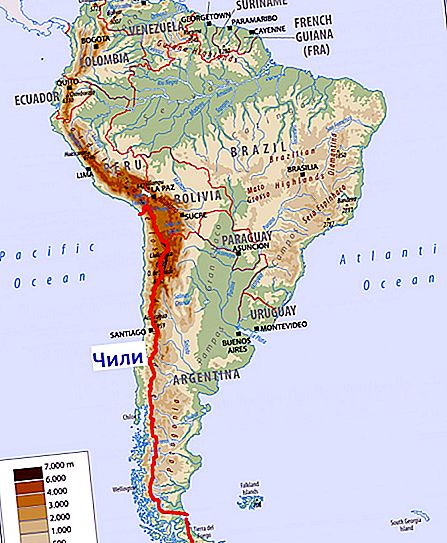In Germany, on the federal state of Saxony, is the city of Leipzig, in which the monument "Battle of the Peoples" is located. Its construction was completed at the beginning of the 20th century, and the construction itself became the most massive in Europe. The monument “Battle of the Peoples” in Leipzig, the history of its construction and features will be described in detail in the article.
Monument history
Talking about the monument “Battle of the Peoples”, it is necessary to consider in honor of what event it was erected. In October 1813, the largest battle of Napoleon’s troops and the coalition of the allied armies of Austria, Russia, Sweden and Prussia took place near Leipzig on October 16-19. As a result of these military clashes, Bonaparte was defeated with his troops, having suffered heavy losses.

The battles took place in Saxony, near Leipzig. At the beginning of the battle on October 16, Napoleonic troops began their successful offensive, but they failed to develop success, and on the 18th they were forced to retreat to Leipzig. The next day, with heavy losses, Napoleon began his retreat to France.
Effects
This victory was as key as that which happened a year earlier, in 1812 near Moscow at Borodino. As a result, the French troops were defeated and forced to flee. The victory in the battle of the peoples was the final in a succession of successes of the Russian-Prussian troops who liberated Germany, right up to the Elbe.
Napoleon’s army, according to some estimates, lost about 80 thousand soldiers in the battles near Leipzig, of which half were killed and wounded, and the rest were captured. The allies lost about 54 thousand people, of which about 23 thousand Russians, 16 thousand Prussians and 15 thousand Austrian soldiers.
Commemorative events were held on the first anniversary of the victory, numerous memorials were created at various points of the battle. After some time, it was decided to erect a large monument in memory of these heroic events.
The construction of the monument
For the first time, the idea to build a large-scale monument was proposed by the German writer and deputy E. M. Arndt. However, not everyone supported the creation of such a monument. For example, Saxony, whose soldiers fought on the side of the Napoleonic army, and that lost part of their territories, was against the erection of the monument.

On the 50th anniversary of the victory, the so-called Napoleon’s stone was laid in the place where his headquarters were located during the legendary battle. Moreover, until the end of the 19th century there were no plans to implement the construction of the Battle of the Peoples monument. In 1898, construction began.
The monument “Battle of the Peoples” near Leipzig was erected according to the project of the famous Berlin architect B. Schmitz. After 15 years, a grand opening took place, which was dedicated to the 100th anniversary of the victory in the battle. One of the initiators of the project was K. Timé, who was the chairman of the German Patriotic Union, as well as the master of the Masonic Leipzig. The bulk of the funds was received through voluntary donations and a specially organized lottery.
general description
The monument "Battle of the Peoples" reaches a height of 91 meters and is located directly in the center of the battlefield. From the base of the monument to its highest viewing platform, 500 steps lead. After the reconstruction of the 21st century, two elevators were built that take visitors to the middle observation platform to a height of 57 m.

Inside the monument “Battle of the Peoples” is the Hall of Fame, on the arch of which there is an image of 324 horsemen almost life-size. Four statues of the so-called commemorative, reaching a height of 9.5 m, are installed in the hall. They embody virtues: the strength of faith, courage, selflessness and popular power.
At the base of the monumental composition is the figure of the archangel Michael, who, in addition to being the main one of the angels, is also considered the patron saint of warriors. Around the head of the archistratigus there is an inscription carved from stone: "St. Michael", and even higher - "God is with us."
This phrase is often found in mentions in connection with the German army of various periods. Around the monument are carved images of battles that amaze with their realism. On the facade there are 12 huge sculptures that rest on the swords of warriors and symbolize the Guardians of Freedom. At the foot of the monument is an artificial reservoir, which is called the Lake of Tears.
Specifications
On the photo of the monument “Battle of the Peoples” you can see its full scale and monumentality. It is worth noting that now it is the largest in Europe. As mentioned earlier, its total height is 91 m, and the main hall with the dome rises to 68 m.

In order to build such a large-scale monument, it was necessary to install 65 fundamental piles on which a slab 80 m long, 70 m wide and 2 m high was built. For the construction of this giant monument, 120 thousand cubic meters of concrete and 26.5 thousand stone were used blocks. The total mass of the structure is 300, 000 tons, and 6 million German gold marks were spent on its construction.




